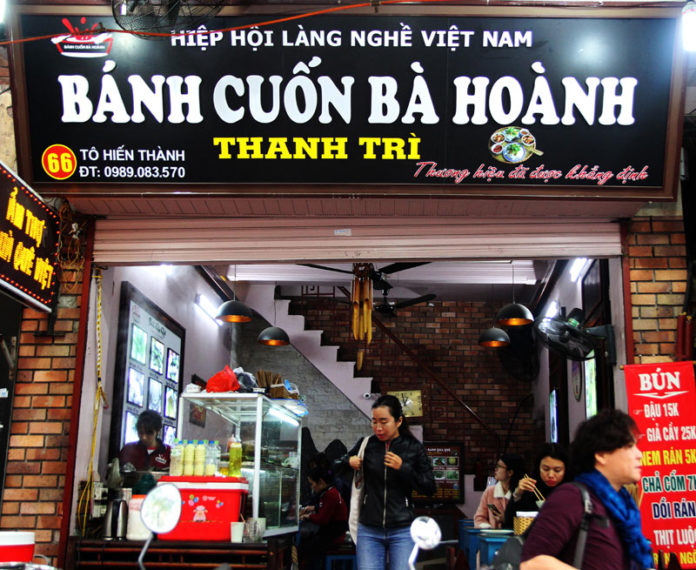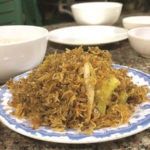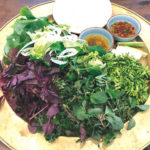The Banh cuon, or steamed rice crepe, is not a luxury food but has become favorite of not only Vietnamese but also foreign visitors to Hanoi.
| The Banh cuon Ba Hoanh restaurant is always packed with diners at the weekend. Photo: Duy Khanh |
“I feel like I’ve just swallowed a piece of ‘silk’,” Marco Lipuma- a friend of our family from Germany exclaimed as soon as he tried his first bite of the Banh cuon. “It’s outstanding, cool and very…slippery,” he said.
After his first taste in early this year, within the following months he’d tried it countless more times. “I don’t like food with rich protein, so this is a good choice and I think it’s also a perfect detox food after so many giant feasts,” he stated.
Truong Kim Dung, a customer of Banh Cuon Ba Hoanh eatery said that she tried the dish some 30 years ago when she got married and moved to live in the neighborhood. Then, she became addicted to banh cuon.
“I love Banh cuon. The texture of Mrs. Hoanh’s steamed rice crepe is gorgeous smooth, flavorsome and delicious. I guess that they must be prepared with high-quality materials,” she told The Hanoi Times.
Dung said that two of her daughters also love the steamed rice crepe made by Mrs. Hoanh’s family but only come here to have the Banh cuon as supper or brunch at the weekend.
The decades long delicacy
| The food has a wonderful texture and great taste. Photo: Thanh Tung |
According to Nguyen Thi Dung, 41, the owner of Banh cuon Ba Hoanh restaurant and also daughter-in-law of Madame Hoanh, the story of Mrs. Hoanh’s steamed rice crepe restaurant dates back around 70 years.
It was when a woman named Ly Thi Hong got married to Nguyen Van Hoanh, originally from Thanh Tri village in Hanoi’s Hoang Mai District, which is famed in the capital for its typical dish: the Banh cuon.
Following the tradition of the time, she took on her husband’s name and became Mrs. Hoanh, and learned the art of making Banh cuon from her mother-in-law. She opened her first humble Banh cuon stall on the footpath on To Hien Thanh Street.
Some years later, in the 1950s, she opened a “real” Banh cuon restaurant at No. 37 To Hien Thanh Street. In the following years, the Banh cuon eatery has become a familiar destination for many Hanoians.
On weekend, there are rows of motorbikes parked in front of the restaurant, and lines of people waiting patiently to be served inside the cramped space. Mrs. Hoanh’ children opened a second, larger restaurant later within a walking distance of the first, which eased the chaos there.
The secret recipe
| The Banh cuon is eaten accompanied with Cha lua or Vietnamese ham, dried onion and coriander. Photo: Thanh Tung |
According to Dung, the owner of the restaurants, the reason for the Banh cuon’s thinness is how it’s made. “Mrs. Hoanh’s banh cuon is extremely thin because it strictly follows the traditional method of cooking,” she said.
“It’s steamed over a fabric-covered pot that can quickly cook the rice flour, keeping it moist and malleable,” she told The Hanoi Times.
A very thin layer of batter is poured on to the cloth and evenly spread and steamed to create a thin layer of rice paper in less than a minute. The chef uses a flat and flexible bamboo stick to lift the delicate rice crepe and places it on a fresh banana leaf. The rice crepes are then served cold later.
Although the Banh cuon is made from familiar ingredients such as rice, oil, and onions, but the combination of such elements creates a special flavor that attracts many diners. One of the secrets to making a delicious steamed rice crepe is choosing good rice.
“Good rice makes a delicious crepe that is thin and silky,” Dung stated.
Another important factor is the sauce, which is a combination of fish sauce, sugar, and kumquat fruit. The diners should not forget topping the dish of Banh cuon with some stir-fried onions, the taste is awesome!
The Banh cuon is inexpensive and Hanoian usually eat them as breakfast or a late supper. The price of a dish of Mrs. Hoanh steamed rice crepe with some slices of Cha lua is VND35,000 (US$1.5).
The Banh cuon Ba Hoanh restaurants are situated at No. 37 & 66 To Hien Thanh Street, Hai Ba Trung District. Opening hours are from 6:00 am to 9:00 pm daily.












